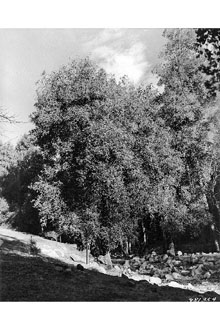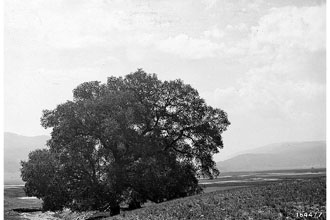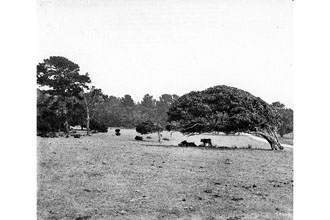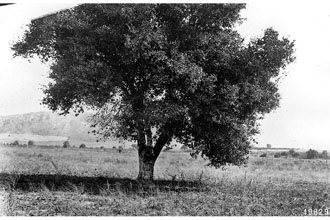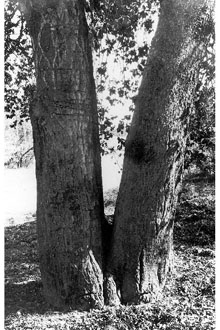California Live Oak
Scientific Name: Quercus agrifolia Née
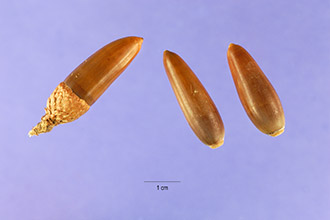
| General Information | |
|---|---|
| Usda Symbol | QUAG |
| Group | Dicot |
| Life Cycle | Perennial |
| Growth Habits | ShrubTree, |
| Native Locations | QUAG |
Plant Guide
Use
Erosion: Coast live oaks stabilize soil on slopes, provide an organic-rich litter, and contribute to a habitat for a diversity of insects, birds, and mammals. Wildlife: Acorns are an important food source for birds, small mammals, and deer. Deer may browse the young foliage. Ethnobotanic: Native Americans used acorns as an important food staple and early European colonists found that its wood made a superior charcoal for use in a variety of industries, including baking and preparing mortar. Landscape and beautification: Coast live oak is an important element in both natural and man-made landscapes, providing shade and an aesthetic quality.
Status
Please consult the PLANTS Web site and your State Department of Natural Resources for this plant’s current status, such as, state noxious status and wetland indicator values, Use soil moisture sensors to measure the soil moisture of California Live Oak.,
Description
General: Oak Family (Fagaceae). Coast live oak, an evergreen tree 10 to 25 m tall, has a broad, dense crown and widely spreading branches. The lower limbs of ungrazed trees often recline on the ground. Mature bark is gray and shallowly furrowed. Leaves are oblong to oval, 2 to 6 cm in length, cupped, with entire to toothed margins. The upper surface is strongly convex, deep green and smooth, but the lower surface is paler, with hairy-tufted vein axils. Like all oaks, coast live oak is monoecious and wind-pollinated. Acorn cups are composed of thin, flat scales. The one-seeded nuts are 2 to 4 cm long, narrowly conical, and mature in one year. On average, trees have high acorn production once every 2 to 3 years. Flowering takes place from February to April. Fruits mature between August and October. Distribution: Coast live oak occurs in the coast ranges from north central California southward to northern Baja California. For current distribution, please consult the Plant Profile page for this species on the PLANTS Web site.
Establishment
Adaptation: It grows in well-drained soils on bluffs, gentle slopes, and canyons, and can be found up to 1400 m in elevation. This species is adapted to relatively warm, wet winters and dry summers moderated by fog and cool temperatures, but does not occur where the ground freezes. Although tolerant of various soil types, live oak prefers a deep loam. Common associates include species of sumac, lemonade berry, and toyon. Coast live oak is particularly well adapted to fire. Branches may produce new shoots after having been lightly burned. Trunks exposed to moderate fires often resprout from the base. Like most oaks, it has an obligate relationship with mycorrhizal fungi, which provide critical moisture and nutrients Propagation by seeds: Oak seeds do not store well and consequently seeds should be planted soon after maturity. Nuts are considered ripe when they separate freely from the acorn cap and fall from the tree. Care should be taken to collect local fruits, because they may be adapted to local environmental conditions. Viable nuts are green to brown and have unblemished walls. Nuts with discoloration or sticky exudates, and small holes caused by insect larvae, should be discarded. Propagation of coast live oak is highly successful by direct seeding at the beginning of winter. Once a site is chosen, prepare holes that are 10 inches in diameter and 4 to 5 inches deep. One gram of a slow-release fertilizer should be placed in the bottom and covered by a small amount of soil. Place 6 to 10 acorns in each hole at a depth of 1 to 2 inches. Temporary enclosures should be used to minimize herbivory by rodents or birds. A simple enclosure can be constructed from a 1 quart plastic dairy container with the bottom removed and a metal screen attached. Near the end of the first season, seedlings should be thinned to 2 or 3 per hole and to 1 seedling by the second season. Supplemental watering may be necessary if a drought of 6 weeks or more occurs during the spring. Container Planting: Seeds may be planted in one-gallon containers, using well-drained potting soil that includes slow-release fertilizer. Tapered plastic planting tubes, with a volume of 10 cubic inches, also may be used. Seeds should be planted 1 to 2 inches deep and the soil kept moist. Seedlings should be transplanted as soon as the first true leaves mature. Planting holes should be at least twice as wide and deep as the container. Seedlings may require watering every 2 to 3 weeks during the first season. Care should be taken to weed and mulch around young plants until they are 6 to 10 inches tall.
Management
Natural live oak regeneration from seeds tends to occur sporadically during winters with above average precipitation that falls evenly throughout the season. Seedlings are especially sensitive to trampling and too herbivory by rodents, deer, and cattle. Common insects include moth larvae and tent caterpillars. Mature trees are especially susceptible to oak crown and root rot fungi (e.g., Inonotus, Ganoderma, and Laetiporus) which decay wood in trunks and roots. Activities that disturb or compact soil around trees, including construction and livestock grazing need to be avoided or carefully managed within the near the zone of leaf canopy. Summer irrigation near oaks should also be avoided, especially in urban landscapes, because it promotes oak root and crown rot. When desirable, mature trees consumed by fires may be allowed to recover from stump sprouts if replanting on large tracts is uneconomical. Cultivars, Improved and Selected Materials (and area of origin) It is best to plant species from your local area, adapted to the specific site conditions where the plants are to be grown. This species is available from most native plant nurseries within its range. Contact your local Natural Resources Conservation Service (formerly Soil Conservation Service) office for more information. Look in the phone book under ”United States Government.” The Natural Resources Conservation Service will be listed under the subheading “Department of Agriculture.”
References
Bleier, C. 1993. A planner’s guide for oak woodlands. University of California Press, Berkeley, California. 94 p. Griffin, J. 1977. Oak woodland. Pages 383-415. IN M. Barbour and J. Major (eds.). Terrestrial vegetation of California. Wiley Interscience, New York, New York. Pavlik, B.M., P.C. Muick, S. Johnson, & M. Popper 1991. Oaks of California. Cachuma Press and the California Oak Foundation, Los Olivos, California. 184 p. Schettler, S. & M. Smith 1980. Nursery propagation of California oaks. Pages 242-245. IN T. Plumb (ed.). Proceedings of the symposium on the ecology, management, and utilization of California oaks. USDA, Forest Service, Pacific Southwest Forest and Range Experiment Station. Technical Report 44.
Plant Traits
Growth Requirements
| Temperature, Minimum (°F) | 7 |
|---|---|
| Adapted to Coarse Textured Soils | Yes |
| Adapted to Fine Textured Soils | No |
| Adapted to Medium Textured Soils | Yes |
| Anaerobic Tolerance | None |
| CaCO3 Tolerance | Low |
| Cold Stratification Required | No |
| Drought Tolerance | Medium |
| Fertility Requirement | Low |
| Frost Free Days, Minimum | 220 |
| Hedge Tolerance | None |
| Moisture Use | Medium |
| pH, Maximum | 7.5 |
| pH, Minimum | 5.5 |
| Planting Density per Acre, Maxim | 800 |
| Planting Density per Acre, Minim | 300 |
| Precipitation, Maximum | 60 |
| Precipitation, Minimum | 20 |
| Root Depth, Minimum (inches) | 36 |
| Salinity Tolerance | Low |
| Shade Tolerance | Intolerant |
Morphology/Physiology
| Bloat | None |
|---|---|
| Toxicity | None |
| Shape and Orientation | Irregular |
| Nitrogen Fixation | None |
| Resprout Ability | No |
| Active Growth Period | Spring, Summer, Fall |
| C:N Ratio | High |
| Coppice Potential | No |
| Fall Conspicuous | No |
| Fire Resistant | No |
| Flower Color | Yellow |
| Flower Conspicuous | No |
| Foliage Color | Green |
| Foliage Porosity Summer | Dense |
| Foliage Porosity Winter | Dense |
| Fruit/Seed Color | Brown |
| Low Growing Grass | No |
| Lifespan | Long |
| Leaf Retention | Yes |
| Known Allelopath | No |
| Height, Mature (feet) | 70.0 |
| Height at 20 Years, Maximum (fee | 25 |
| Growth Rate | Slow |
| Growth Form | Single Crown |
| Fruit/Seed Conspicuous | Yes |
| Foliage Texture | Medium |
Reproduction
| Vegetative Spread Rate | None |
|---|---|
| Small Grain | No |
| Seedling Vigor | High |
| Seed Spread Rate | Slow |
| Fruit/Seed Period End | Fall |
| Seed per Pound | 200 |
| Propagated by Tubers | No |
| Propagated by Sprigs | No |
| Propagated by Sod | No |
| Propagated by Seed | Yes |
| Propagated by Corm | No |
| Propagated by Container | Yes |
| Propagated by Bulb | No |
| Propagated by Bare Root | Yes |
| Fruit/Seed Persistence | No |
| Fruit/Seed Period Begin | Summer |
| Fruit/Seed Abundance | Medium |
| Commercial Availability | Routinely Available |
| Bloom Period | Early Spring |
| Propagated by Cuttings | No |
Suitability/Use
| Veneer Product | No |
|---|---|
| Pulpwood Product | No |
| Post Product | No |
| Palatable Human | No |
| Palatable Browse Animal | Medium |
| Nursery Stock Product | Yes |
| Naval Store Product | Yes |
| Lumber Product | Yes |
| Fuelwood Product | High |
| Fodder Product | No |
| Christmas Tree Product | No |
| Berry/Nut/Seed Product | No |

